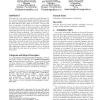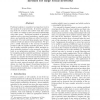241 search results - page 11 / 49 » Understanding Social Networks Using Formal Concept Analysis |
CHI
2010
ACM
14 years 2 months ago
2010
ACM
In this work we analyze the behavior on a company-internal social network site to determine which interaction patterns signal closeness between colleagues. Regression analysis sug...
PODC
2010
ACM
13 years 9 months ago
2010
ACM
The study of complex networks led to the belief that the connectivity of network nodes generally follows a Power-law distribution. In this work, we show that modeling large-scale ...
EMSOFT
2006
Springer
13 years 11 months ago
2006
Springer
We report on a case study in which the model checker Uppaal is used to formally model parts of Zeroconf, a protocol for dynamic configuration of IPv4 link-local addresses that has...
COMAD
2009
13 years 8 months ago
2009
Positional analysis is considered an important tool in the analysis of social networks. It involves partitioning of the set of actors into subsets such that actors in a subset are...
CHI
2006
ACM
14 years 8 months ago
2006
ACM
Our current understanding of human interaction with hybrid or augmented environments is very limited. Here we focus on `tangible interaction', denoting systems that rely on e...


